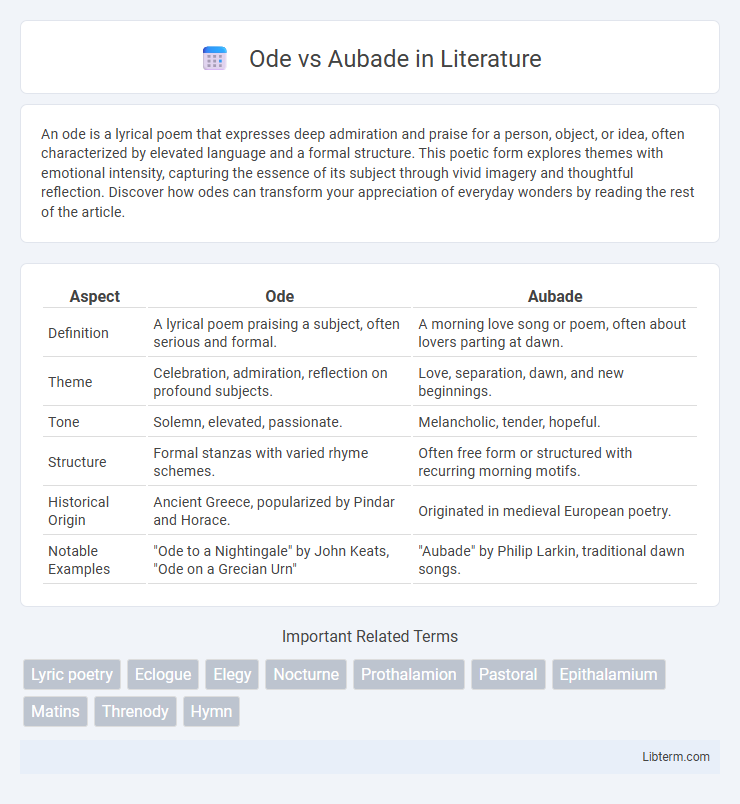An ode is a lyrical poem that expresses deep admiration and praise for a person, object, or idea, often characterized by elevated language and a formal structure. This poetic form explores themes with emotional intensity, capturing the essence of its subject through vivid imagery and thoughtful reflection. Discover how odes can transform your appreciation of everyday wonders by reading the rest of the article.
Table of Comparison
| Aspect | Ode | Aubade |
|---|---|---|
| Definition | A lyrical poem praising a subject, often serious and formal. | A morning love song or poem, often about lovers parting at dawn. |
| Theme | Celebration, admiration, reflection on profound subjects. | Love, separation, dawn, and new beginnings. |
| Tone | Solemn, elevated, passionate. | Melancholic, tender, hopeful. |
| Structure | Formal stanzas with varied rhyme schemes. | Often free form or structured with recurring morning motifs. |
| Historical Origin | Ancient Greece, popularized by Pindar and Horace. | Originated in medieval European poetry. |
| Notable Examples | "Ode to a Nightingale" by John Keats, "Ode on a Grecian Urn" | "Aubade" by Philip Larkin, traditional dawn songs. |
Understanding Ode and Aubade: Definitions
An ode is a lyrical poem expressing praise or deep emotion, often structured with elaborate stanza forms and elevated language, celebrating subjects like nature, art, or individuals. An aubade is a morning love song or poem, traditionally depicting lovers parting at dawn, characterized by its focus on themes of farewell and the transition from night to day. Understanding these definitions highlights odes as celebratory and formal, while aubades are intimate and time-specific, usually capturing the mood of early morning.
Historical Origins of Ode and Aubade
The ode originated in ancient Greece as a lyrical poem sung with musical accompaniment, often used to celebrate heroic deeds or express intense emotions, prominently developed by poets like Pindar and Horace. The aubade, emerging in medieval Europe, traditionally marked the dawn and romantic partings, frequently featured in troubadour poetry and early Renaissance song. Both forms evolved through centuries, reflecting cultural shifts while maintaining their distinct thematic and structural identities.
Key Characteristics of Odes
Odes are lyrical poems characterized by their formal tone, structured stanza patterns, and exalted themes that often praise a person, object, or abstract concept. They exhibit elevated language, intricate metaphors, and a serious, reflective mood aimed at evoking deep emotional responses. Unlike aubades, which focus on dawn and separation, odes emphasize admiration and reverence through elaborate expressions and rhythmic complexity.
Key Features of Aubades
Aubades are morning love songs or poems traditionally expressing lovers' sorrow at parting at dawn, characterized by a focus on themes of separation and awakening. Key features include a lyrical portrayal of dawn, intimate dialogue between lovers, and an emphasis on time and nature's transition from night to day. Distinct from odes, aubades often convey a gentle, melancholic tone centered on farewell and the inevitability of daybreak.
Major Themes in Odes vs Aubades
Odes predominantly explore themes of admiration, celebration, and deep emotional reflection, often addressing subjects like love, nature, and heroism with elevated language. Aubades focus primarily on the themes of parting and the bittersweet moments of dawn, capturing emotions related to lovers' separations and the transition from night to day. While odes emphasize grandeur and intensity, aubades convey intimacy and the poignancy of morning farewells.
Famous Examples of Odes and Aubades
Famous odes include John Keats' "Ode to a Nightingale," which explores themes of beauty and mortality, and Pablo Neruda's "Ode to Salt," celebrating everyday objects with rich imagery. Renowned aubades feature John Donne's "The Sun Rising," depicting the morning as a lover's song, and Philip Larkin's "Aubade," which meditates on the dread of death at dawn. Both forms vividly express emotional states tied to specific times, with odes often praising a subject and aubades focusing on the departure of night or lovers.
Structure and Form: Ode vs. Aubade
Odes typically feature a formal, often elaborate structure with stanzas called strophes, antistrophes, and epodes, emphasizing exalted themes and complex rhyme schemes. Aubades are usually shorter lyric poems that capture the morning's first light or dawn, often with a more straightforward, stanzaic form centered around themes of parting lovers or new beginnings. While odes adopt a grand and ceremonial tone, aubades maintain a tender, reflective mood through simpler, rhythmic patterns.
Notable Poets of Ode and Aubade Traditions
Notable poets of the ode tradition include John Keats, whose "Ode on a Grecian Urn" exemplifies the form's deep emotional expression and lyrical complexity. Aubades, celebrated for their dawn-time theme of lovers parting, feature poets like Philip Larkin and Richard Wilbur, who masterfully capture the intimate melancholy of morning farewells. Both forms highlight the emotional intensity and stylistic nuances characteristic of these poetic genres.
Modern Interpretations and Adaptations
Modern interpretations of odes often emphasize personal reflection and emotional depth, moving beyond classical formal structures to incorporate contemporary themes such as identity and social issues. Aubades have evolved to explore themes of separation and intimacy within modern relationships, frequently adapting their traditional dawn-setting to more abstract temporal or emotional transitions. Both forms are increasingly used in experimental poetry and multimedia art, blending traditional motifs with innovative language and formats.
Choosing Between Ode and Aubade in Creative Writing
When choosing between an ode and an aubade in creative writing, consider the thematic focus and emotional tone of the piece. An ode typically celebrates or praises a person, object, or concept with elevated language and formal structure, ideal for expressing admiration or deep reflection. In contrast, an aubade centers on the early morning or dawn, often exploring themes of parting lovers or new beginnings, making it suitable for capturing moments of transition or intimate farewell.
Ode Infographic

 libterm.com
libterm.com